Southern Italy’s faraway-feeling seaside gem is well within your grasp. Here’s how to experience the Amalfi Coast with savvy and style.
Southern Italy’s Amalfi Coast seems to be on everyone’s bucket list, even the well-traveled, giving it something of an impossible dream quality. The common misconception is it’s a tough place to reach or afford (or both).
You can explore the Amalfi Coast modestly or in high style, spending anywhere from $200 to $2,000 a night. Either way, you'll have a magical time and no doubt have plans to return.
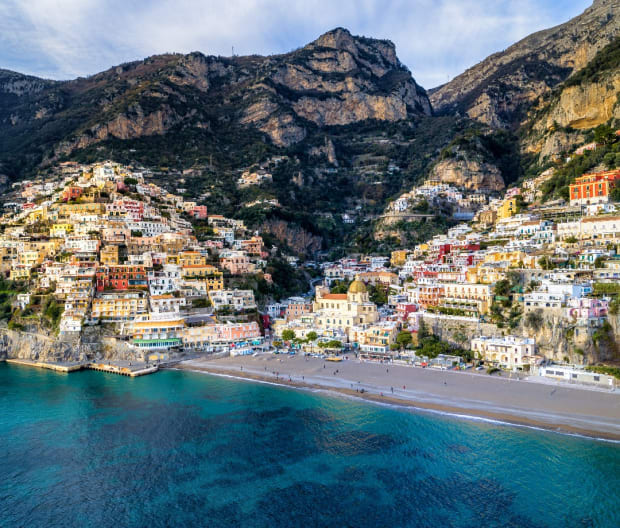
Getty Images/Gian Lorenzo Ferretti Photography
Where Is the Amalfi Coast?
The Amalfi Coast is a 25-mile stretch of legendary shore in southern Italy along the Tyrrhenian Sea. The most popular section, from Positano to Maiori, is just eight twisty miles. It's a 1.5-hour drive south from Naples, the closest big city.
Best Time to Visit the Amalfi Coast
It's no secret that the Amalfi Coast is heavily touristed with visitors of all kinds—from jetsetters to backpackers and everything in between—for nearly half the year. The old advice was to avoid July and especially August. Nowadays, June and even May and early September can be packed with crowds now too.
Our recommendation is to get on a plane as soon as feasibly possible this spring, or else wait until later September into October when the throngs thin and the sea temperature is still perfect for swimming. By November, as with most European resort destinations, things start to shut down.
What to Do on the Amalfi Coast
First-time travelers will want to hit the major towns of Positano, Amalfi, and Ravello—but off-the-beaten path options abound in this compact area that will help you make the place your own.
While it’s almost inevitable that travelers will try and second guess which iconic coastal resort in this country is worth seeing first—the Amalfi Coast or the Italian Riviera—the easy answer is that you can’t go wrong either way. Full of history, charm, and stunning scenery, each is unique enough that you’ll just have to settle for experiencing both. That said, the following four days down south might just tip the scale.
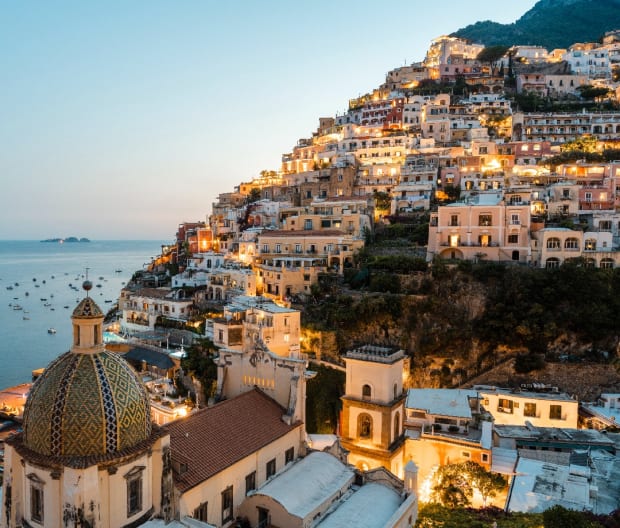
Getty Images/Marco Bottigelli
Day 1: Positano
If you’re leaving from the East Coast of the U.S., plan an overnight flight departing in the afternoon that will get you into Rome by early the following morning with the six-hour time difference. Rome isn’t exactly around the corner from the Amalfi Coast, but it’s close enough. A local driver can get you to Positano in a little more than three hours. Or, using public transport, take the high-speed train to Salerno, which takes only 90 minutes. The latter will slightly overshoot the Amalfi Coast, but this way you’re avoiding traffic, buses, and sketchy local trains. From the Salerno train station, walk to the ferry terminal (less than half a mile) for an unbeatable intro to the coast—and proof that there’s nothing like arriving by sea.
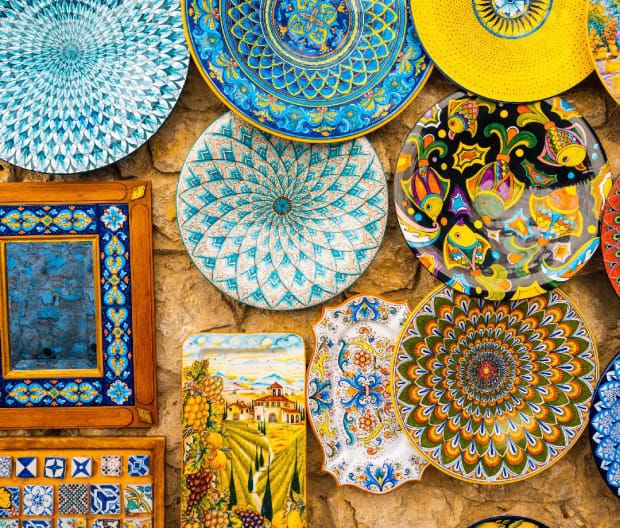
Getty Images/Marco Bottigelli
Begin in glamorous Positano and work your way east. From the water, you’ll recognize the town by the famed green- and yellow-tiled dome of the Church of Santa Maria Assunta. Positano is a magical mixture of refinement and casual authenticity. A delightful jumble of multicolored villas and hotels climbs up the hillside, which is like a half-bowl above the dark pebbles of the main beach, Spiaggia Grande. You can get happily lost among the narrow pedestrian walkways, peeking into high-style boutiques and art galleries. Vines and bougainvillea adorn the exterior walls and form shady canopies.

Drew Limsky
Unlike most Italian towns, there’s no central piazza, which encourages wandering. Eventually you’ll make it down to the seafront, which is lined with open-air, scene-y restaurants like Chez Black. You can rent chairs and umbrellas, grab a gelato, and kayak or swim from cove to cove in the dark, aquamarine waters. Come 6 p.m., you’ll hear the church bells ring while local boys play soccer on the beach, and feel like you’re in a mid-century Italian film.
For a change of intoxicating atmosphere, walk a bit west to the second beach, Fornillo, which is lined with beach bars and offers an even more laid-back and natural vibe. Between the two, keep your eyes peeled for a tiny, breathtaking cove where a flight of stone stairs invites a private swim.
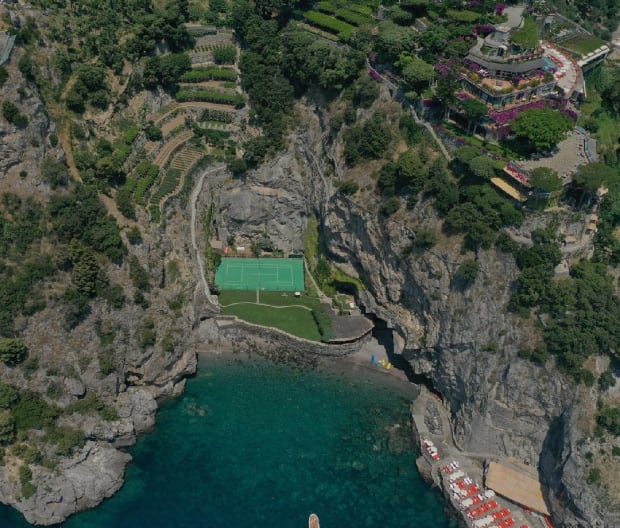
Courtesy Image
A bit outside of town sits one of the world’s top resorts, the spectacularly situated Il San Pietro di Positano. Rising from a tiny cape, the Relais & Chateaux hotel owned and managed by the legendary Vito Cinque boasts terraced gardens, romantic restaurants, and rooms and suites (no two alike) with panoramic views of the coast. An elevator, carved into the cliff, brings guests to the private beach and sundeck.
Day 2: Hidden Spots Around Positano
By taxi or bus, it’s time to experience the serpentine Amalfi Drive. Score a seat on the right to enjoy the vertiginous seaside views. But today, don’t head all the way to Amalfi (45 minutes away). The typical experience is to watch the coast during the drive to Amalfi and wonder about the signs on the road in between the two towns. Below those signs, down the cliff, are adorable, often moderately priced hotels, restaurants, and beach clubs. They offer a level of privacy and semi-remoteness that most visitors never experience, especially on a first trip.
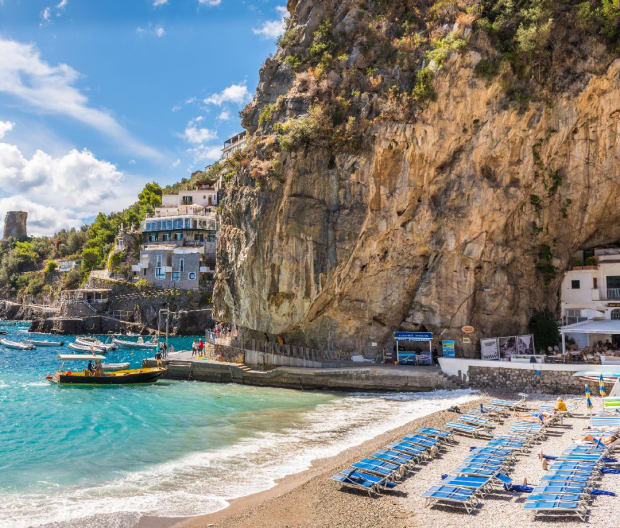
Getty Images/Andrea Comi
On the edge of Praiano, make sure you spend time at Il Pirata. A flower-lined path leads to this lovely beach club—though the “beach” is a series of platforms (rent a lounge chair) where you can jump in the water and work up an appetite for its fine seafood. The life-changing pasta dish here is prepared with zucchini, provolone, and parmesan.
If you find that this kind of local scene is your thing, just down the road is Marina di Praia, a proper cliff-backed beach that’s accessed via a coastal walkway beneath a rock ceiling. There are only a handful of restaurants and bars, boatmen bringing in tourists and the day’s catch, and a lively atmosphere.
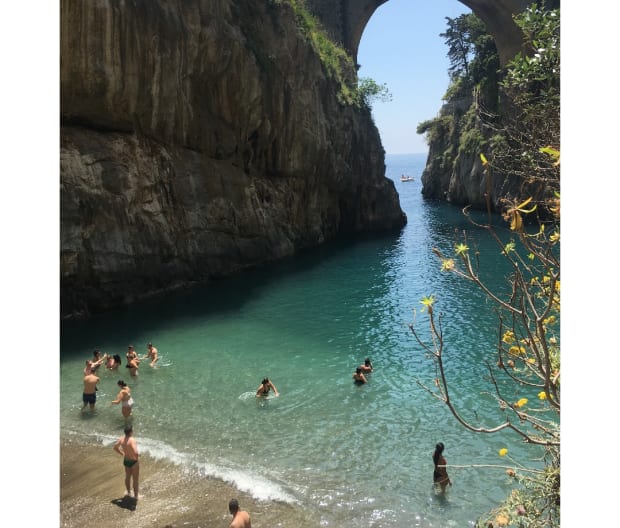
Drew Limsky
Feeling even more adventurous? It’s about 10 minutes down the coast to Fiordo di Furore. There’s no real town to mark the spot, but you can use your phone to hop off the bus before a bridge. Beneath that bridge (lots of stairs) is the much-photographed fjord—a narrow cove that snakes under the arches of the bridge to a small pebbly beach. There aren’t any services, but the swimming is sublime.

Drew Limsky
End your day with dinner at La Locanda del Fiordo. The moderately priced hotel set on multiple lushly landscaped levels is a true cliffside find where you can dive in and explore caves at the bottom. As it happens, the street-side restaurant at this little gem is so beloved that people book tables to enjoy the brilliant insalata di mare (seafood salad). As you dine, reflect on the fact that you’ve experienced treasures of the Amalfi Coast that few tourists here have even heard of, much less been to.
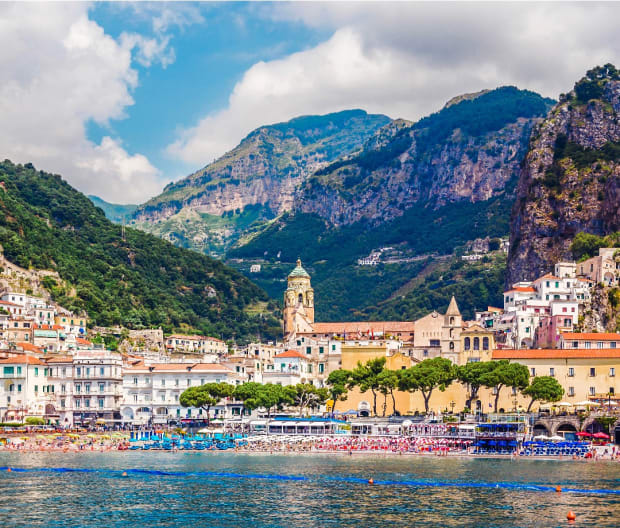
Getty Images: Larisa Shpineva/EyeEm
Day 3: Amalfi & Ravello
You’ll immediately notice that the iconic town of Amalfi has a different texture and layout than Positano. Once the bus or taxi drops you off on the waterfront, strolling under an arch leads to a vaguely symmetrical layout somewhat redolent of a Cinque Terre town at first, with a cute piazza and a fountain at its center. As you ascend past boutiques selling linen shirts, gelaterias (the local lemon is prized), and artisanal pizza places, cut to the left or right to find a half-hidden staircase and explore how the locals live and grow their lemons on these steep hillsides. The imposing 9th-century Cathedral of St. Andrew, with its striped marble Byzantine façade, lords over the town square—and there’s nothing in Cinque Terre quite like that.
Upscale Ravello is conveniently located on the mountain above Amalfi. About 30 minutes of precipitous, hairpin turns by taxi or bus, Ravello with its polished feel and storied history is worth the commute. Greta Garbo would holiday here. Author Gore Vidal made his home here. One of his favorite spots was the 11th-century Villa Cimbrone, which you can wander for a few euros. High above the sea, the Terrazza dell’Infinito (Terrace of Infinity), lined by marble busts, is one of the most iconic spots in all of Italy.
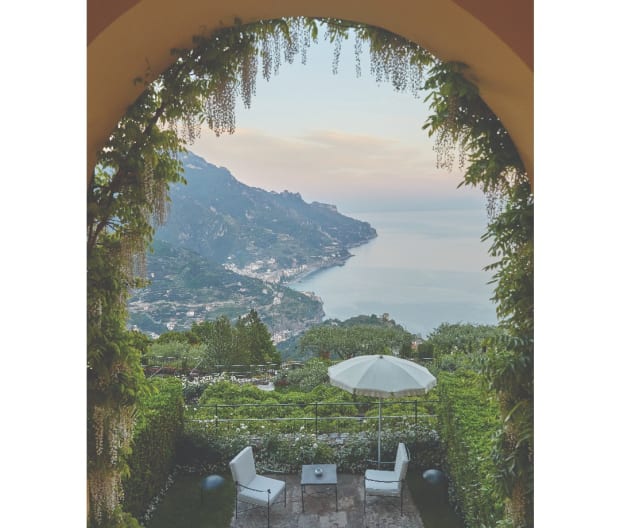
Courtesy of Belmond
In a coastal region blessed with unforgettable hotels, Hotel Caruso, which dates from the 11th century and is managed under the Belmond luxury brand, stands out for its splendor. “The infinity pool looks like a ship heading to the line of the horizon where sea and sky can't be distinguished one from the other,” says managing director Alfonso Pacifico. If you’re able to tear yourself away from this palace where even the fitness center enjoys an incredible view and the signature Caruso suite offers a private garden suspended over the Amalfi Coast, the hotel offers a complimentary daily boat tour.
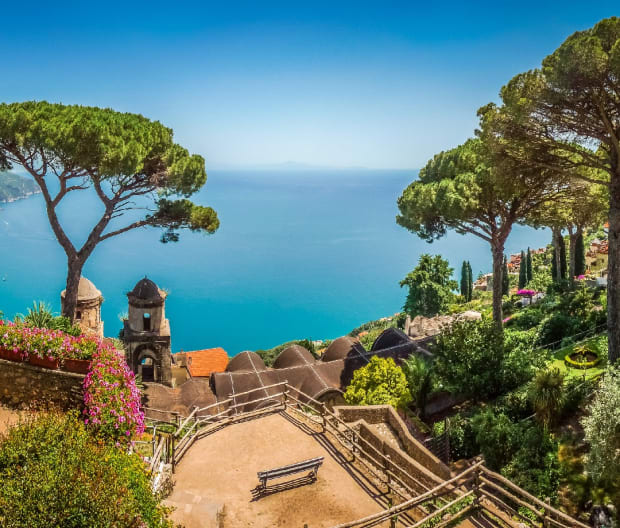
Getty Images/bluejayphoto
Day 4: Hiking the Coast
Centuries before there were cars or roads, residents used their own two feet. Today, the Amalfi Coast remains a place of fabulous hiking. After three days of pasta and gelato, head toward the multiple stairways that will bring you from the rarefied heights of Ravello to the edge of the sea. If you’re flying out of Rome in the afternoon, you’ll have time in the morning to hike down to the paired towns of Minori and Maiori. Take a swim off the sandy beach of either or both. Minori, as its name suggests, is compact, while Maiori is more horizontal, featuring a palm-lined promenade.
Minori's popular Pasticceria Sal De Riso opens at 7 a.m.—so fill up a bag of tortes and other pastries while you’re down on the seafront. Just know that the taste of the Amalfi Coast will linger even longer than the limoncello cream in the panettone.
from Men's Journal https://ift.tt/KIy2j9E
via IFTTT
